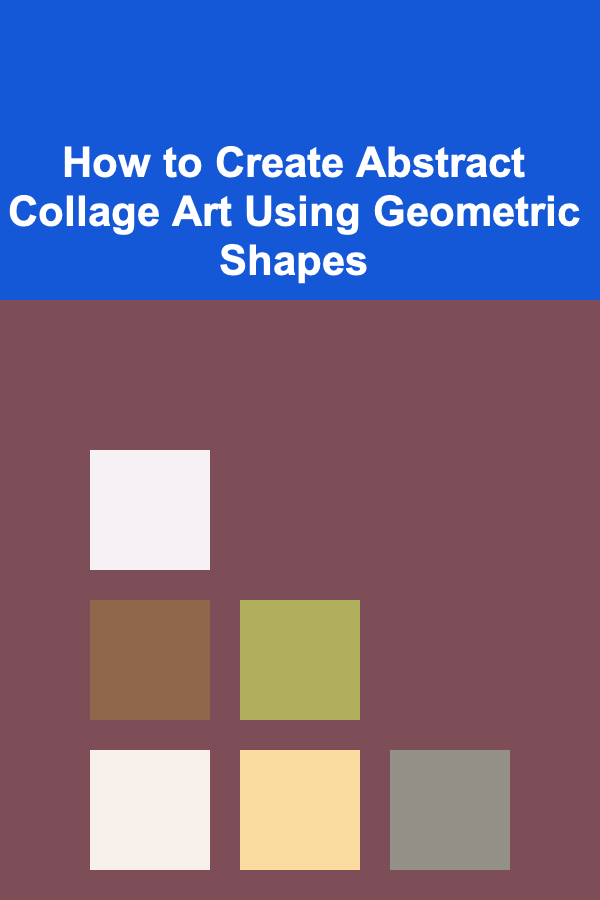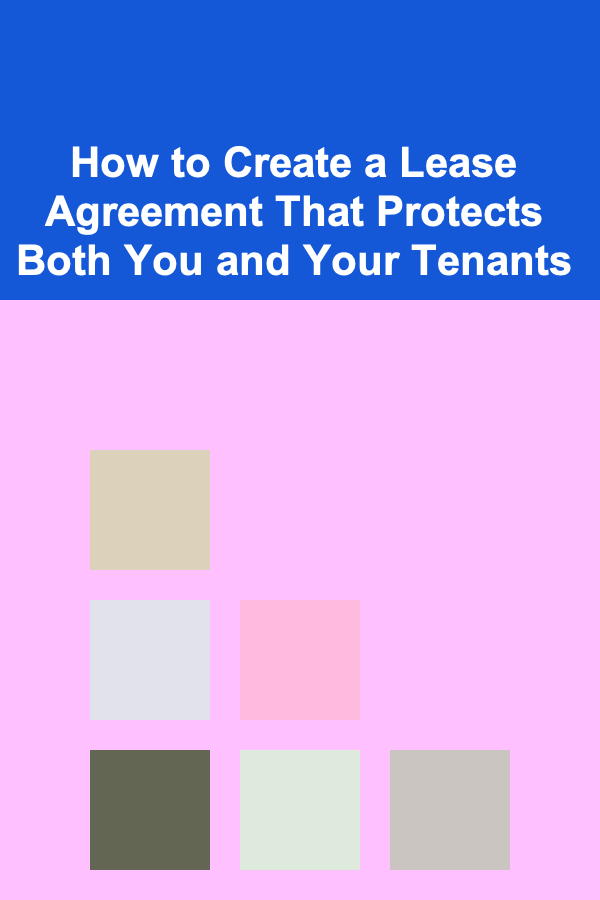
How to Create Abstract Collage Art Using Geometric Shapes
ebook include PDF & Audio bundle (Micro Guide)
$12.99$9.99
Limited Time Offer! Order within the next:

Abstract art, particularly in the form of collage, has long been a powerful medium for expressing creativity and challenging traditional artistic norms. Collage art allows artists to break down boundaries by combining different materials and visual elements, creating something new and unexpected. When you introduce geometric shapes into the mix, it adds another layer of intrigue and precision, resulting in a balanced yet dynamic composition.
In this article, we will explore how to create abstract collage art using geometric shapes. By the end, you will have a deeper understanding of the tools, techniques, and creative principles involved in crafting stunning geometric collage art.
Understanding Abstract Collage Art
Before diving into the specifics of geometric shapes, it's essential to understand what makes abstract collage art unique. Abstract art is a genre that focuses on visual elements rather than realistic depictions of the world. It often utilizes shapes, colors, textures, and forms to evoke emotions or convey ideas.
Collage, on the other hand, is an artistic technique that involves assembling various materials, such as paper, fabric, photographs, and even found objects, onto a surface to create a unified composition. The juxtaposition of these materials can evoke new meanings, challenging the viewer's perception and creating a space for interpretation.
When abstract art meets collage, it allows for a more freeform and experimental approach. Artists can take advantage of both the tactile qualities of different materials and the visual impact of abstract compositions.
The Role of Geometric Shapes in Abstract Collage Art
Geometric shapes are defined by their mathematical structure, including lines, angles, and proportions. Some of the most common geometric shapes in art are circles, squares, triangles, rectangles, and polygons. While geometric shapes are often associated with precision and order, they can also be used in abstract collage to create visual tension, rhythm, and balance.
Why Use Geometric Shapes?
- Structure and Balance: Geometric shapes offer a sense of structure in an otherwise chaotic medium. They help establish a framework that can bring harmony to the overall composition.
- Visual Interest: The repetitive nature of geometric shapes, combined with their precise angles and lines, creates a visual rhythm that keeps the viewer engaged.
- Contrast and Tension: When combined with organic or freeform elements, geometric shapes can create intriguing contrasts that draw attention to particular areas of the artwork.
- Versatility: Geometric shapes are versatile and can be manipulated in various ways---rotated, scaled, or repeated---to create dynamic and evolving compositions.
Materials You Will Need
Creating abstract collage art using geometric shapes requires a few basic tools and materials. These materials will serve as the foundation for your creative process and help bring your artistic vision to life.
1. Collage Base:
- Paper or Canvas: Choose a sturdy surface like watercolor paper, mixed media paper, or canvas. Your choice of surface will affect how the materials adhere to it and the overall texture of the final piece.
- Cardboard: For a more durable base, consider using cardboard. It provides a solid foundation for layering materials.
2. Geometric Shape Cutouts:
- Scissors or Craft Knife: To cut clean, sharp geometric shapes out of paper, cardboard, or fabric.
- Geometric Stencils: Pre-made stencils can help you achieve precise shapes, especially for circles and triangles.
- Computer Software (optional): If you want to design and print digital geometric shapes, software like Adobe Illustrator or even basic tools like Microsoft Word can be useful.
3. Adhesive:
- Glue Stick or Mod Podge: These are ideal for securing paper cutouts to your base. Mod Podge also works as a sealer to create a glossy finish if desired.
- Double-Sided Tape: For a cleaner look, especially with thin, delicate paper.
- PVA Glue: PVA glue is perfect for securing heavier materials or when layering multiple elements.
4. Additional Materials for Layering:
- Magazines and Newspapers: Great for texture and adding variety to your collage.
- Fabric Scraps: Add tactile quality and depth with fabrics.
- Textured Papers: Papers with different textures (e.g., tissue paper, handmade paper) can be used to create contrast.
- Paint: Acrylic paints or watercolors can add color to the background or highlight specific areas of the collage.
- Markers or Pens: Fine-tipped pens can be used to outline shapes, add details, or enhance the geometric elements.
Steps for Creating Abstract Collage Art Using Geometric Shapes
Step 1: Define Your Concept
Before you start cutting and pasting, take a moment to think about the message or feeling you want to express. The use of geometric shapes in collage art can evoke a sense of harmony, balance, chaos, or order. You may want to play with the interplay of shapes and colors, or you may choose to emphasize specific geometric forms like circles or triangles.
Consider the following when developing your concept:
- Mood: Is your artwork calm and orderly, or is it more dynamic and chaotic?
- Color Palette: Decide if you want to use a limited color palette or explore vibrant contrasting colors.
- Texture: Think about incorporating texture through materials like fabric or newspaper clippings to add depth to the composition.
Step 2: Select Geometric Shapes
Once you have an idea of the concept, begin selecting your geometric shapes. Decide which shapes will best represent your ideas. For instance:
- Circles: Perfect for creating a sense of wholeness or unity.
- Triangles: Often associated with tension, direction, and movement.
- Squares and Rectangles: Symbolize stability and order.
- Polygons: More complex, these shapes can introduce visual interest and variety.
Use stencils, rulers, or freehand techniques to create precise or freeform shapes. Experiment with overlapping shapes, irregular angles, and different sizes to create dynamic compositions.
Step 3: Cutting Out the Shapes
Using your scissors, craft knife, or cutting tool, carefully cut out the shapes from your chosen materials. You can use colored paper, magazine clippings, or even fabric for this step. Pay attention to the edges, making sure they are clean and precise, as jagged or uneven cuts may disrupt the flow of your design.
Step 4: Arrange the Shapes
Start arranging the cut-out shapes on your collage base. Don't glue them down immediately---experiment with different placements until you find a composition that feels balanced and visually appealing. Consider the principles of design such as:
- Balance: Distribute shapes evenly or create asymmetry for a more dynamic feel.
- Contrast: Use contrasting shapes (e.g., a large square with a small circle) to create visual interest.
- Rhythm: Repeat certain shapes or patterns to establish a sense of rhythm across the collage.
- Proximity: Group similar shapes together to form focal points or create a sense of unity.
Step 5: Glue the Shapes Down
Once you are satisfied with the arrangement, begin gluing the shapes onto the base. Start with the shapes in the background and layer the others on top. Make sure to apply the adhesive evenly and securely to prevent edges from lifting.
If you're working with multiple layers or mixed media, be mindful of the textures and thicknesses of your materials. You might need to adjust your glue choices based on the weight of the materials.
Step 6: Add Color and Texture
Now that your geometric shapes are in place, you can enhance the collage with color and texture. Use acrylic paints, watercolors, or markers to add additional color to specific areas of the collage. You can also apply texture by adding fabric pieces, textured paper, or even materials like sand or thread to give your piece more depth.
Layering different textures on top of the geometric shapes can add complexity and intrigue. You may want to keep the background more muted or neutral, allowing the geometric shapes to stand out as the focal point of the artwork.
Step 7: Refine Your Composition
Take a step back and evaluate the overall composition. Adjust the shapes or colors if necessary to achieve the balance you desire. You may decide to add more geometric shapes or even create patterns that echo throughout the piece. Experiment with different techniques, such as shading or layering, to refine the visual flow.
Step 8: Seal Your Artwork
Once you're satisfied with the composition, consider sealing the entire piece with a layer of Mod Podge or acrylic medium. This will give your collage a uniform finish and help preserve it over time. A glossy finish can add a polished look, while a matte finish can provide a more subdued, textured appearance.
Conclusion
Creating abstract collage art using geometric shapes offers endless possibilities for artistic expression. By understanding the unique role of geometric forms and combining them with collage techniques, you can produce visually captivating artworks that play with form, texture, and color. The process requires both creativity and patience, but the result is a striking and dynamic piece that reflects your vision.
Whether you're new to abstract collage or an experienced artist, experimenting with geometric shapes will allow you to develop a fresh perspective on your art. Don't be afraid to push the boundaries, mix different materials, and explore the endless combinations of geometric shapes to create something uniquely your own.
Reading More From Our Other Websites
- [Organization Tip 101] How to Choose the Right Chimney Cap for Your Home
- [Biking 101] How to Adjust Your Bike Stem for Better Control and Handling
- [Soap Making Tip 101] Eco-Friendly Soap Making: How to Reduce Waste with Zero-Packaging Recipes
- [Soap Making Tip 101] Bubbly Fun: Simple Soap-Making Projects Kids Can Master
- [Small Business 101] Small Business Resources: Free Tools and Support to Help You Grow
- [Home Pet Care 101] How to Prepare for a Safe and Stress-Free Pet Travel Experience
- [Personal Investment 101] How to Choose Between ETF vs Mutual Fund for Your Retirement Savings
- [Home Soundproofing 101] How to Use Acoustic Panels to Soundproof Your Home
- [Small Business 101] How to Create a Seamless Remote Hiring Process for a Growing Small Business
- [Gardening 101] How to Start and Care for Your Succulent Garden

How to Create a Lease Agreement That Protects Both You and Your Tenants
Read More
How to Create the Illusion of More Space in Your Home
Read More
How to Organize Digital Resources and References
Read More
How to Store Your Holiday Gifts Effectively
Read More
How to Visit Religious Sites with Reverence
Read More
How to Improve Your Focus and Concentration: A Deep Dive
Read MoreOther Products

How to Create a Lease Agreement That Protects Both You and Your Tenants
Read More
How to Create the Illusion of More Space in Your Home
Read More
How to Organize Digital Resources and References
Read More
How to Store Your Holiday Gifts Effectively
Read More
How to Visit Religious Sites with Reverence
Read More